
Chlorfenvinphos is the common name of an organophosphorus compound that was widely used as an insecticide and an acaricide. The molecule itself can be described as an enol ester derived from dichloroacetophenone and diethylphosphonic acid. Chlorfenvinphos has been included in many products since its first use in 1963. However, because of its toxic effect as a cholinesterase inhibitor it has been banned in several countries, including the United States and the European Union. Its use in the United States was cancelled in 1991.
Demeton-S-methyl is an organic compound with the molecular formula C6H15O3PS2. It was used as an organothiophosphate acaricide and organothiophosphate insecticide. It is flammable. With prolonged storage, Demeton-S-methyl becomes more toxic due to formation of a sulfonium derivative which has greater affinity to the human form of the acetylcholinesterase enzyme, and this may present a hazard in agricultural use.

Phosalone is an organophosphate chemical commonly used as an insecticide and acaricide. It is developed by Rhône-Poulenc in France but EU eliminated it from pesticide registration on December 2006.

Organotin compounds or stannanes are chemical compounds based on tin with hydrocarbon substituents. Organotin chemistry is part of the wider field of organometallic chemistry. The first organotin compound was diethyltin diiodide ((C2H5)2SnI2), discovered by Edward Frankland in 1849. The area grew rapidly in the 1900s, especially after the discovery of the Grignard reagents, which are useful for producing Sn-C bonds. The area remains rich with many applications in industry and continuing activity in the research laboratory.

Dimethoate is a widely used organophosphate insecticide and acaricide. It was patented and introduced in the 1950s by American Cyanamid. Like other organophosphates, dimethoate is an acetylcholinesterase inhibitor which disables cholinesterase, an enzyme essential for central nervous system function. It acts both by contact and through ingestion. It is readily absorbed and distributed throughout plant tissues, and is degraded relatively rapidly.

Dioxathion, systematically known as p-dioxane-2,3-diyl ethyl phosphorodithioate, is an organophosphate pesticide. It is used as an insecticide on livestock and as an acaricide on citrus fruits, deciduous fruits and nuts.
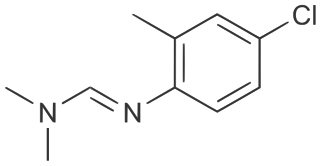
Chlordimeform is an acaricide (pesticide) active mainly against motile forms of mites and ticks and against eggs and early instars of some Lepidoptera insects. After the International Agency for Research on Cancer reported sufficient evidence that its major metabolite, 4-chloro-o-toluidine, was a carcinogen, its use has ceased and its registration has been withdrawn in most countries.

Carbophenothion also known as Stauffer R 1303 as for the manufacturer, Stauffer Chemical, is an organophosphorus chemical compound. It was used as a pesticide for citrus fruits under the name of Trithion. Carbophenothion was used as an insecticide and acaricide. Although not used anymore it is still a restricted use pesticide in the United States. The chemical is identified in the US as an extremely hazardous substance according to the Emergency Planning and Community Right-to-Know Act.
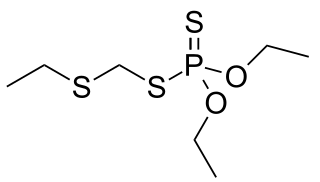
Phorate is an organophosphate used as an insecticide and acaricide.
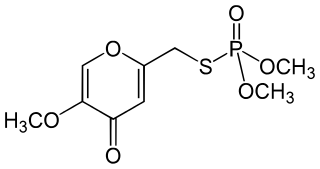
Endothion is an organic compound used as an insecticide and acaricides. It is part of the chemical class of organophosphorus compounds. It is generally described as white crystals with a slight odor. It is used as an insecticide, but not sold in the United States or Canada.

Formetanate is an insecticide and acaricide. It is used on alfalfa grown for seed and on some fruits, including citrus, pome, and stone fruits.
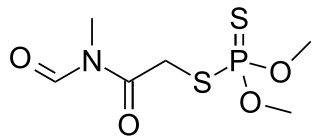
Formothion (chemical formula: C6H12NO4PS2) is a chemical compound used in acaricides and insecticides.

Formparanate (chemical formula: C12H17N3O2) is a chemical compound used in acaricides and insecticides.

Metolcarb (chemical formula: C9H11NO2) is a chemical compound used as an acaricide and an insecticide.
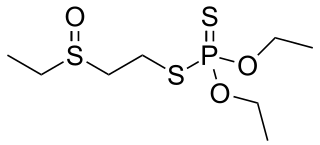
Oxydisulfoton is a chemical compound used as an acaricide and insecticide. It is classified as an extremely hazardous substance in the United States as defined in Section 302 of the U.S. Emergency Planning and Community Right-to-Know Act, and is subject to strict reporting requirements by facilities which produce, store, or use it in significant quantities.

Dimethyl 4-(methylthio)phenyl phosphate is a chemical compound used as an insecticide and an acaricide.

Prothoate is an organothiophosphate insecticide also used as an acaricide.

Thiofanox is a chemical compound used in acaricides and insecticides.

Fluralaner (INN) is a systemic insecticide and acaricide that is administered orally or topically. The U.S. Food and Drug Administration (FDA) approved it under the trade name Bravecto for flea treatment in dogs in May 2014 and Bravecto Plus as a topical treatment for cats in November 2019, with warnings about possible side effects in both species. The EU approved the drug in February 2014. Australia approved it for the treatment and prevention of ticks and fleas on dogs in January 2015.

Dienochlor is an organochlorine compound included in the group of cyclic chlorinated hydrocarbons. Its chemical formula is C
10Cl
10. Dienochlor is mostly used as a pesticide and ovicide.



















